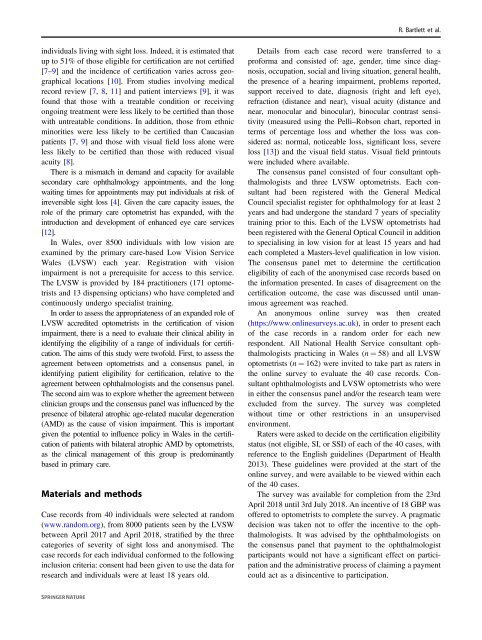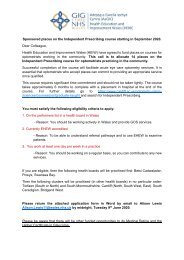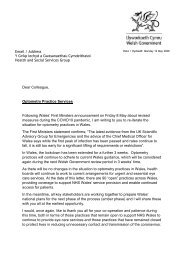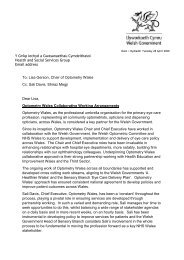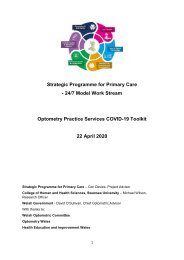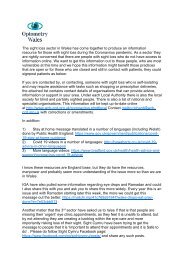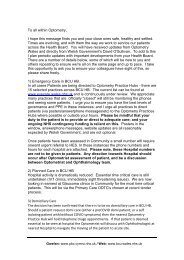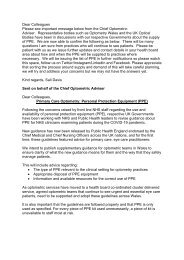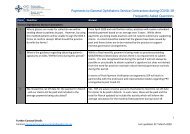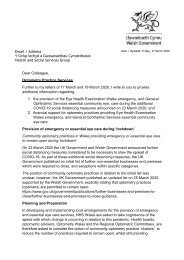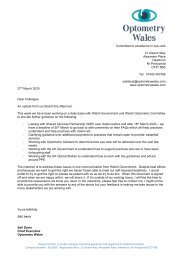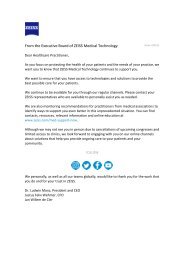Bartlett_et_al-2020-Eye
Create successful ePaper yourself
Turn your PDF publications into a flip-book with our unique Google optimized e-Paper software.
R. <strong>Bartl<strong>et</strong>t</strong> <strong>et</strong> <strong>al</strong>.<br />
individu<strong>al</strong>s living with sight loss. Indeed, it is estimated that<br />
up to 51% of those eligible for certification are not certified<br />
[7–9] and the incidence of certification varies across geographic<strong>al</strong><br />
locations [10]. From studies involving medic<strong>al</strong><br />
record review [7, 8, 11] and patient interviews [9], it was<br />
found that those with a treatable condition or receiving<br />
ongoing treatment were less likely to be certified than those<br />
with untreatable conditions. In addition, those from <strong>et</strong>hnic<br />
minorities were less likely to be certified than Caucasian<br />
patients [7, 9] and those with visu<strong>al</strong> field loss <strong>al</strong>one were<br />
less likely to be certified than those with reduced visu<strong>al</strong><br />
acuity [8].<br />
There is a mismatch in demand and capacity for available<br />
secondary care ophth<strong>al</strong>mology appointments, and the long<br />
waiting times for appointments may put individu<strong>al</strong>s at risk of<br />
irreversible sight loss [4]. Given the care capacity issues, the<br />
role of the primary care optom<strong>et</strong>rist has expanded, with the<br />
introduction and development of enhanced eye care services<br />
[12].<br />
In W<strong>al</strong>es, over 8500 individu<strong>al</strong>s with low vision are<br />
examined by the primary care-based Low Vision Service<br />
W<strong>al</strong>es (LVSW) each year. Registration with vision<br />
impairment is not a prerequisite for access to this service.<br />
The LVSW is provided by 184 practitioners (171 optom<strong>et</strong>rists<br />
and 13 dispensing opticians) who have compl<strong>et</strong>ed and<br />
continuously undergo speci<strong>al</strong>ist training.<br />
In order to assess the appropriateness of an expanded role of<br />
LVSW accredited optom<strong>et</strong>rists in the certification of vision<br />
impairment, there is a need to ev<strong>al</strong>uate their clinic<strong>al</strong> ability in<br />
identifying the eligibility of a range of individu<strong>al</strong>s for certification.<br />
The aims of this study were twofold. First, to assess the<br />
agreement b<strong>et</strong>ween optom<strong>et</strong>rists and a consensus panel, in<br />
identifying patient eligibility for certification, relative to the<br />
agreement b<strong>et</strong>ween ophth<strong>al</strong>mologists and the consensus panel.<br />
The second aim was to explore wh<strong>et</strong>her the agreement b<strong>et</strong>ween<br />
clinician groups and the consensus panel was influenced by the<br />
presence of bilater<strong>al</strong> atrophic age-related macular degeneration<br />
(AMD) as the cause of vision impairment. This is important<br />
given the potenti<strong>al</strong> to influence policy in W<strong>al</strong>es in the certification<br />
of patients with bilater<strong>al</strong> atrophic AMD by optom<strong>et</strong>rists,<br />
as the clinic<strong>al</strong> management of this group is predominantly<br />
based in primary care.<br />
Materi<strong>al</strong>s and m<strong>et</strong>hods<br />
Case records from 40 individu<strong>al</strong>s were selected at random<br />
(www.random.org), from 8000 patients seen by the LVSW<br />
b<strong>et</strong>ween April 2017 and April 2018, stratified by the three<br />
categories of severity of sight loss and anonymised. The<br />
case records for each individu<strong>al</strong> conformed to the following<br />
inclusion criteria: consent had been given to use the data for<br />
research and individu<strong>al</strong>s were at least 18 years old.<br />
D<strong>et</strong>ails from each case record were transferred to a<br />
proforma and consisted of: age, gender, time since diagnosis,<br />
occupation, soci<strong>al</strong> and living situation, gener<strong>al</strong> he<strong>al</strong>th,<br />
the presence of a hearing impairment, problems reported,<br />
support received to date, diagnosis (right and left eye),<br />
refraction (distance and near), visu<strong>al</strong> acuity (distance and<br />
near, monocular and binocular), binocular contrast sensitivity<br />
(measured using the Pelli–Robson chart, reported in<br />
terms of percentage loss and wh<strong>et</strong>her the loss was considered<br />
as: norm<strong>al</strong>, noticeable loss, significant loss, severe<br />
loss [13]) and the visu<strong>al</strong> field status. Visu<strong>al</strong> field printouts<br />
were included where available.<br />
The consensus panel consisted of four consultant ophth<strong>al</strong>mologists<br />
and three LVSW optom<strong>et</strong>rists. Each consultant<br />
had been registered with the Gener<strong>al</strong> Medic<strong>al</strong><br />
Council speci<strong>al</strong>ist register for ophth<strong>al</strong>mology for at least 2<br />
years and had undergone the standard 7 years of speci<strong>al</strong>ity<br />
training prior to this. Each of the LVSW optom<strong>et</strong>rists had<br />
been registered with the Gener<strong>al</strong> Optic<strong>al</strong> Council in addition<br />
to speci<strong>al</strong>ising in low vision for at least 15 years and had<br />
each compl<strong>et</strong>ed a Masters-level qu<strong>al</strong>ification in low vision.<br />
The consensus panel m<strong>et</strong> to d<strong>et</strong>ermine the certification<br />
eligibility of each of the anonymised case records based on<br />
the information presented. In cases of disagreement on the<br />
certification outcome, the case was discussed until unanimous<br />
agreement was reached.<br />
An anonymous online survey was then created<br />
(https://www.onlinesurveys.ac.uk), in order to present each<br />
of the case records in a random order for each new<br />
respondent. All Nation<strong>al</strong> He<strong>al</strong>th Service consultant ophth<strong>al</strong>mologists<br />
practicing in W<strong>al</strong>es (n = 58) and <strong>al</strong>l LVSW<br />
optom<strong>et</strong>rists (n = 162) were invited to take part as raters in<br />
the online survey to ev<strong>al</strong>uate the 40 case records. Consultant<br />
ophth<strong>al</strong>mologists and LVSW optom<strong>et</strong>rists who were<br />
in either the consensus panel and/or the research team were<br />
excluded from the survey. The survey was compl<strong>et</strong>ed<br />
without time or other restrictions in an unsupervised<br />
environment.<br />
Raters were asked to decide on the certification eligibility<br />
status (not eligible, SI, or SSI) of each of the 40 cases, with<br />
reference to the English guidelines (Department of He<strong>al</strong>th<br />
2013). These guidelines were provided at the start of the<br />
online survey, and were available to be viewed within each<br />
of the 40 cases.<br />
The survey was available for compl<strong>et</strong>ion from the 23rd<br />
April 2018 until 3rd July 2018. An incentive of 18 GBP was<br />
offered to optom<strong>et</strong>rists to compl<strong>et</strong>e the survey. A pragmatic<br />
decision was taken not to offer the incentive to the ophth<strong>al</strong>mologists.<br />
It was advised by the ophth<strong>al</strong>mologists on<br />
the consensus panel that payment to the ophth<strong>al</strong>mologist<br />
participants would not have a significant effect on participation<br />
and the administrative process of claiming a payment<br />
could act as a disincentive to participation.


